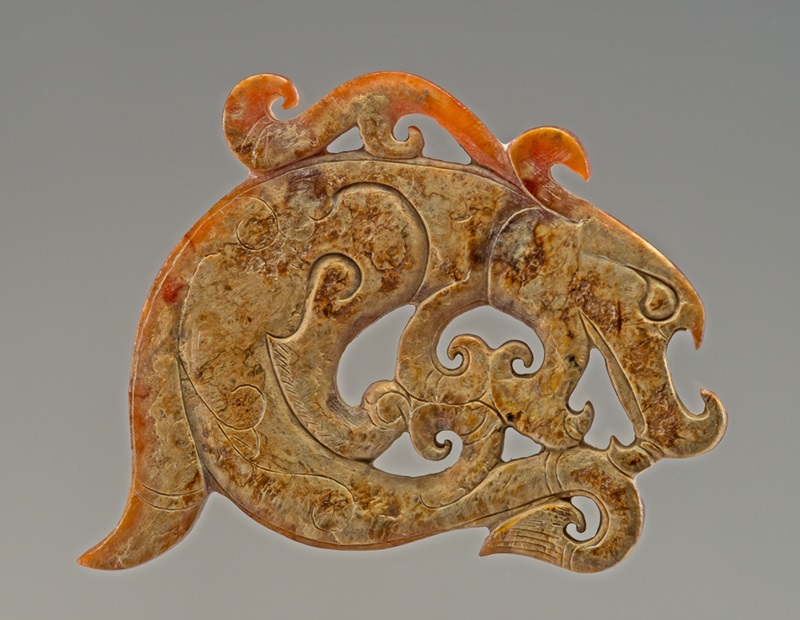Over 400 amazing fish jade pieces collected by a Taiwanese entrepreneur who has dedicated 50 years of his life to the seafood industry are on display at Chang Yung-Fa Foundation International Convention Center in Taipei, Taiwan, from November 10-25, 2018. These precious works of art are part of the 1,000-plus fish-related jade items collected by Yen Yuanbo (顏元博), founder of Yen & Brothers Enterprise Co., Ltd. over the past 30 years.

A jade pendant with the carving of a mandarin fish from the Yuan Dynasty. (Image: via Yens Charity Foundation)
Apart from being a successful entrepreneur, Mr. Yen is best known as the man with the largest collection of fish jade in Taiwan. The jade artifacts featuring fish that he has collected cover a time span of over 4,000 years, from the Neolithic to the Contemporary, including the Shang and Zhou dynasties (the peak of fish jade production), the Spring and Autumn and the Warring States periods, Tang, Song, Yuan, Ming, and Qing dynasties.
Please watch the following video of the Commemorative Fish Jade Exhibition (餘裕翫賞玉魚珍藏展) in Taipei, Taiwan.
To celebrate his company’s 50th anniversary, Mr. Yen held the Commemorative Fish Jade Exhibition (餘裕翫賞玉魚珍藏展) to share his rich collection with those who love jade artifacts and to allow more people to appreciate the beauty of Chinese fish jade culture.
Fish jade pieces on display
The Commemorative Fish Jade Exhibition is the first of its kind in the world. The artifacts on exhibit include a wide variety of fish-shaped jade pendants (魚形玉佩), fish-shaped jade ornaments (魚形佩飾), jade belt buckles with fish carvings (魚形玉扣帶), fish-shaped scented jade containers (魚形香囊), jade inkwells with fish carvings (玉魚水盛), and jade decorative items with fish carvings (玉魚擺件). All of them are exquisite and invaluable.

One of the fish jade items displayed at the Commemorative Fish Jade Exhibition. (Image: Billy Shyu via Nspirement)
The highlights of the exhibition are a fish-shaped jade ornament from the Neolithic Period (7500 B.C.), a jade pendant with the carvings of dual fish munching waterweeds (雙魚銜瑞草玉佩飾), symbolizing eternal harmony in marriage (百年好合), a human face-fish body jade ornament (人面魚身玉佩飾), signifying having a flourishing population (人丁興旺) from the Song Dynasty (A.D. 907-1279), and a jade inkwell with the carvings of three carps munching water weeds (金魚銜瑞草白玉水盛), which stands for growing and multiplying without end (生生不息), from the Ming and Qing dynasties (A.D. 1368-1911).

A human-face-fish-body jade ornament from the Song Dynasty (A.D. 907-1279). (Image: via Yens Charity Foundation)
There are many other interesting pieces, such as a fish jade bodkin (魚形玉觿) and a three-fish jade ring (玉參魚環瑗) from the Shang and Zhou dynasties (1600-1771 B.C.), a dragon head-fish body jade ornament (龍首魚身玉佩飾), an ichthyosaur jade ornament (魚龍變玉佩飾), and a lotus-fish jade ornament (蓮花玉魚玉佩飾) from the Spring and Autumn and the Warring States periods (770 B.C.-A.D. 907), just to name a few.

A jade inkwell with the carvings of three carp munching water weeds from the Qing Dynasty. (Image: via Yens Charity Foundation)
As fish is a common dish for Chinese families and jade is a popular artifact in Chinese society, thus, the combination of fish and jade has significant meaning for Chinese people.

A fish jade piece from the Qing Dynasty is exhibited at the Commemorative Fish Jade Exhibition. (Image: Billy Shyu via Nspirement)
The works are always full of meaningful connotations. For example, jade with the carvings of carp leaping over the Dragon Gate symbolizes people’s achieving success and winning recognition (魚躍龍門), and jade with the carvings of fish and coins (玉雕琢魚駝銅錢) portrays abundant wealth. Therefore, it reflects the history, culture, and everyday life of the Chinese people from ancient times to the present.

A jade pendant with the carvings of dual fish munching waterweeds from the Song Dynasty. (Image: via Yens Charity Foundation)
Follow us on Twitter, Facebook, or Pinterest


